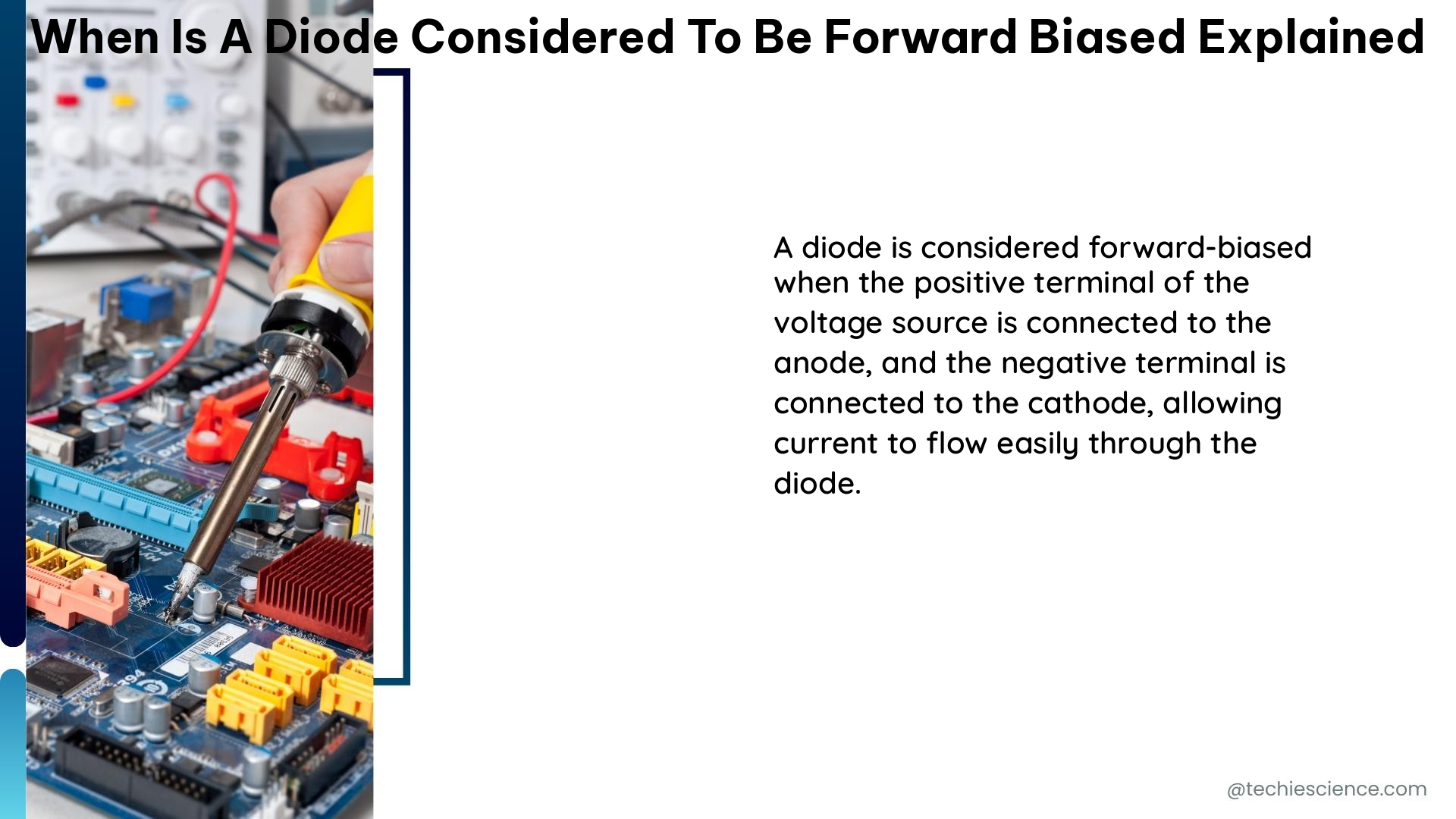A diode is a semiconductor device that allows the flow of electric current in only one direction, acting as a one-way valve for electrons. When a diode is forward biased, it means that a positive voltage is applied to its anode, making the voltage anywhere on the positive voltage side of the origin. This forward bias condition allows the diode to conduct current and behave as a low-resistance path for the flow of electrons.
Understanding Forward Bias in Diodes
In a forward-biased diode, the positive terminal of the external voltage source is connected to the anode, and the negative terminal is connected to the cathode. This configuration reduces the potential barrier of the diode’s p-n junction, allowing electrons to flow freely from the n-type region to the p-type region.
The key characteristics of a forward-biased diode are:
-
Voltage Drop: In normal operation, the voltage across a forward-biased silicon diode is typically between 0.6 to 0.7 volts. This voltage drop is due to the potential barrier that the electrons must overcome to cross the p-n junction.
-
Current Flow: When the voltage applied across the diode exceeds the forward voltage drop, measurable current starts to flow through the diode in the forward direction. As the voltage increases above 0.7 volts, the current flow rises rapidly.
-
Potential Barrier Reduction: The forward bias voltage reduces the strength of the potential barrier of the electric field across the p-n junction, allowing current to flow more easily across the junction.
Electron and Hole Movement in Forward Bias

In the forward bias condition, the movement of charge carriers within the diode can be explained as follows:
-
Electron Current: The negative side of the external bias voltage pushes the majority carriers in the n-region, which are free electrons, toward the p-n junction. This provides a continuous flow of electrons into the n-region through the external connection or the conductor.
-
Overcoming the Barrier Potential: With the help of the external bias voltage, the free electrons can now overcome the barrier potential of the depletion region and move into the p-region.
-
Electron-Hole Recombination: Once the free electrons pass through the junction, they immediately combine with the holes in the valence band of the p-region, becoming valence electrons.
-
Hole Current: The holes in the p-region become the pathway for the valence electrons to move toward the left end of the p-region, as they are attracted to the positive side of the external bias voltage. This hole movement can be considered as the hole current.
Quantitative Analysis of Forward Bias
To further understand the behavior of a forward-biased diode, let’s consider some quantitative details:
-
Voltage Range: In normal operation, the voltage across a forward-biased silicon diode is typically between 0.6 to 0.7 volts. This voltage drop is a characteristic of the diode’s material and junction properties.
-
Current Flow: When the voltage applied across the diode exceeds the forward voltage drop, measurable current starts to flow through the diode in the forward direction. As the voltage increases above 0.7 volts, the current flow rises rapidly, often in an exponential manner.
-
Barrier Potential Reduction: The forward bias voltage reduces the strength of the potential barrier of the electric field across the p-n junction, typically from around 0.7 volts (the built-in potential) down to a much lower value, allowing current to flow more easily across the junction.
-
Diode Characteristics: The specific characteristics of a forward-biased diode, such as the voltage drop, current flow, and barrier potential reduction, can vary depending on the diode’s material, doping levels, and other design parameters.
Practical Applications of Forward-Biased Diodes
Forward-biased diodes have numerous practical applications in electronic circuits, including:
-
Rectification: Diodes are commonly used in rectifier circuits to convert alternating current (AC) to direct current (DC) by allowing current to flow in only one direction.
-
Voltage Regulation: Diodes can be used in voltage regulator circuits to maintain a constant output voltage, even with fluctuations in the input voltage or load.
-
Signal Clamping: Forward-biased diodes can be used to clamp signal levels, preventing them from exceeding a certain voltage threshold.
-
Logic Gates: Diodes can be used in simple logic gate circuits, such as AND and OR gates, to perform basic digital logic operations.
-
LED Drivers: Forward-biased diodes are essential in driving light-emitting diodes (LEDs) by providing the necessary current and voltage drop for their proper operation.
By understanding the principles of forward bias in diodes, electronics engineers and technicians can design and troubleshoot a wide range of electronic circuits and devices effectively.
References:
– What is Meant When a Diode is Said to be Forward Biased?
– Diode Biasing: Forward and Reverse Bias Diodes Explained
– How Does a Diode Work? Part 2: Forward Bias
– Forward Bias vs. Reverse Bias and Their Effects on Diode Functionality
– Diode Circuit Element
– Diode Forward Bias
– Diode Forward Characteristics
– Diode Forward Bias Voltage

The lambdageeks.com Core SME Team is a group of experienced subject matter experts from diverse scientific and technical fields including Physics, Chemistry, Technology,Electronics & Electrical Engineering, Automotive, Mechanical Engineering. Our team collaborates to create high-quality, well-researched articles on a wide range of science and technology topics for the lambdageeks.com website.
All Our Senior SME are having more than 7 Years of experience in the respective fields . They are either Working Industry Professionals or assocaited With different Universities. Refer Our Authors Page to get to know About our Core SMEs.